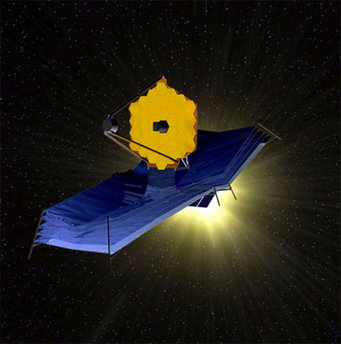Top German Technology for Hubble’s Successor
Carl Zeiss and Max Planck researchers develop technology for the world’s largest space telescope
Carl Zeiss Optronics, in Oberkochen, Germany, and the Max Planck Institute for Astronomy in Heidelberg (MPIA), are developing the main fine mechanical optical technology for two instruments to be part of the James Webb Space Telescope (JWST). Over the next eight years, under administration of the European Space Agency and NASA in the USA, the JWST (with a mirror of 6.5 metres) will shape up to be the successor to the legendary HUBBLE Space Telescope. Carl Zeiss and the Max Planck Institute signed a contract on November 29 to co-operate in their work on the MIRI and NIRSpec instrumentation of the JWST.

The JAMES WEBB Space Telescope is going to replace the Hubble Space Telescope in the next few decades as the most important tool for astronomical observation. The most important scientific goal of the mission is to discover the "first light" of the early universe - the formation of the first stars out of the slowly cooling Big Bang. The light from these first stars and galaxies has shifted into the infrared spectrum because its wavelength has stretched out some twenty times, as the universe has been expanding. The infrared (warm) radiation of the telescope and its instruments could disturb these weak cosmic signals. In order to prevent this, the telescope has to be essentially deep frozen.
For this reason, the JWST will be stationed at the "Lagrangian point L2", 1.5 million kilometres outside the Earth’s orbit. The gravitational forces of the Sun and the Earth balance each other at L2, so the JWST can maintain a position synchronous with the sun and the Earth, permanently on the far side of the Earth from the sun. Here, the telescope and its instruments will cool down to -230 degrees Celsius. The extremely high sensitivity and resolution of the huge telescope will lead to entirely new insights about the formation of stars and planets in the Milky Way Galaxy. These investigations are only possible in the infrared spectrum. Unlike visible light, infrared light can pass through the thick gas and dust clouds, in which planets and stars form, without being appreciably weakened.

The telescope and its instruments make immense demands. They will be subject to initial stress at an acceleration much higher than the Earth’s, and then cooled down to a temperature almost reaching absolute zero (-273 degrees Celsius). After the telescope is put into operation at its final location, its astronomical instruments will be adjusted to a high level of accuracy and have to be kept there - roughly equivalent to targeting the point of a needle from a one-kilometre distance.
The Space Telescope has three instruments on board for data recording: MIRI, NIRSpec, and NIRCam. MIRI and NIRSpec are being developed and built in Europe. Carl Zeiss and the MPIA will be making a major contribution, as the only European representatives, to both instruments.
For the MIRI and NIRSpec, Carl Zeiss will deliver the filter and grating changing mechanisms which allow the instruments to be precisely configured for various types of observation. The MPIA will also be participating in their development and testing. Futhermore, Carl Zeiss will be delivering two filter and grating mechanisms for the NIRSpec instrument to EADS Astrium. The contract that Carl Zeiss and the MPIA signed specifies that they will co-operate in producing both instruments.
The MIRI and NIRSpec mechanisms are similar, related projects. Their development and testing will take place in the next two-and-a-half years; after that, Carl Zeiss and the MIPA will install them. It is planned that in the year 2013, a European Ariane 5 rocket will bring the JWST to the Lagrangian point L2. The entire operation with MIRI and NIRSpec is being organised by the European Space Agency, the German Aerospace Center, and the Max Planck Society.
Carl Zeiss and the Max Planck Institute for Astronomy have already worked together successfully on challenging projects developing space instruments. One example is ISOPHOT, a major contribution to the success of the European Infrared Space Observatory, ISO. Recently, they began co-operating on the PACS instrument of the HERSCHEL European space observatory, set to start operations in 2008.
Carl Zeiss and the MPIA have won a great deal of trust from international partners through their co-operation. Now, the two organisations are setting foot on terra nova: astronomers from Heidelberg hope to observe the borders of the cosmic "dark ages", before stars started to form. Together, they are looking forward to developing optomechanical systems of unprecedented quality. They will guarantee both success for the astronomical "flagship" mission JWST, and a competitive edge for all kinds of imaginable future applications.

